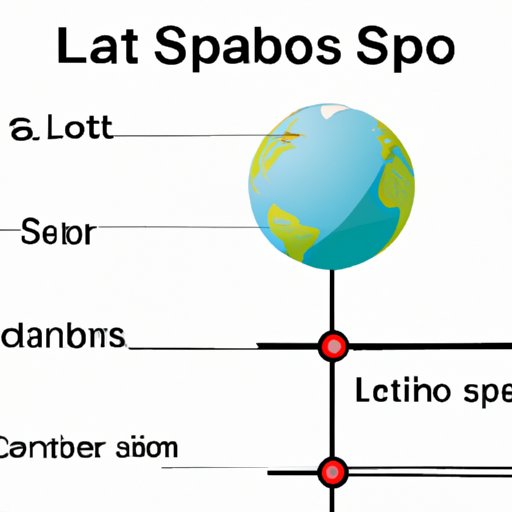Introduction
Satellites have been a part of our lives since the late 1950s when the Soviet Union launched Sputnik 1. Since then, satellites have grown in number and complexity, with thousands of them orbiting Earth at any given time. While satellites are an essential part of our day-to-day lives, most people don’t think about the physics behind their movement or the forces that keep them in orbit. In this article, we explore how fast do satellites travel and the factors that influence their speed.
A Breakdown of Satellite Speed: How Fast Do Satellites Orbit?
Satellites orbit the Earth at various speeds depending on the type of orbit they’re in. Low Earth Orbits (LEO) can move at speeds upwards of 18,000 miles per hour, while Geostationary Orbits (GEO) can reach speeds of 7,000 miles per hour. Medium Earth Orbits (MEO) can move anywhere between these two speeds.
The speed of a satellite is also affected by other factors such as its mass, size, and proximity to Earth. Additionally, the position of a satellite in its orbit can influence its speed.
Exploring the Physics Behind Satellite Travel Speeds
The physics behind satellite travel involves understanding the forces that impact a satellite’s flight path. These include gravity, centrifugal force, and drag. Gravity pulls the satellite towards the center of the Earth, while centrifugal force pushes it away. Drag, which is caused by air resistance, slows the satellite down.
The mathematics of orbital mechanics, which is the study of how objects move in space, is also important in understanding the speed of satellites. It involves using equations to calculate the speed and trajectory of a satellite in orbit. This knowledge is essential for engineers and scientists who design and launch satellites.
How Do We Measure the Speed of a Satellite?
Measuring the speed of a satellite requires special instruments. Radar systems are used to track the movements of satellites and other objects in space. These systems use radio waves to measure the distance and speed of objects in orbit. Other instruments such as accelerometers, gyroscopes, and magnetometers are also used to measure the speed of satellites.
Calculating velocity is also important in determining the speed of a satellite. Velocity is calculated by dividing the displacement (change in position) of an object over a certain period of time. This allows us to measure the speed of a satellite in both kilometers per second and miles per hour.
What Factors Affect the Speed of a Satellite?
There are several factors that can affect the speed of a satellite. The mass and size of a satellite can influence its speed, as larger and heavier satellites will experience more drag than smaller ones. Proximity to Earth is another factor that can influence speed, as satellites closer to Earth experience more drag than those farther away.
The position of a satellite in its orbit can also affect its speed. For example, satellites in higher orbits tend to move faster than those in lower orbits. Finally, solar activity can influence the speed of a satellite, as increased solar activity can cause the atmosphere to expand, resulting in increased drag.

Comparing Different Types of Satellites and Their Travel Speeds
Low Earth Orbits (LEO) are typically used for communication, observation, and navigation purposes. These orbits typically range from 100 to 2000 kilometers above the surface of the Earth and can move at speeds of up to 18,000 miles per hour. Geosynchronous Orbits (GEO) are used for communications and broadcasting purposes. These orbits are placed 22,236 miles above the equator and can reach speeds of up to 7,000 miles per hour.
Medium Earth Orbits (MEO) are used for navigation and communication purposes. These orbits are located between 500 and 20,000 kilometers above the Earth’s surface and can reach speeds of up to 12,000 miles per hour.

An Overview of the History of Satellite Travel Speeds
Early attempts at estimating the speed of satellites were based on observations of their motion. As technology improved, scientists began to develop mathematical models to accurately estimate the speed of satellites. These models allowed engineers to design and build satellites that could reach specific orbits and travel at predetermined speeds.
Advances in technology have also enabled us to measure the speed of satellites more accurately. Radar systems and other instruments are now able to measure the exact speed of satellites in orbit, allowing us to better understand their movements and trajectories.
Conclusion
In conclusion, satellites travel at varying speeds depending on their type of orbit and the factors that influence their movement. Low Earth Orbits (LEO) are the fastest, reaching speeds upwards of 18,000 miles per hour, while Geosynchronous Orbits (GEO) and Medium Earth Orbits (MEO) are slower, reaching speeds of 7,000 and 12,000 miles per hour, respectively. Measuring the speed of satellites requires specialized instruments, and advances in technology have enabled us to measure their speed more accurately.
Understanding the physics behind satellite travel and the forces that affect their speed is essential for engineers and scientists who design and launch satellites. With this knowledge, satellites can be designed and launched to reach specific orbits and travel at predetermined speeds.
This article has explored how fast does a satellite travel, discussing types of orbits and their speeds, the physics behind satellite travel speeds, the instruments used to measure speed, and the factors that affect the speed of a satellite.
(Note: Is this article not meeting your expectations? Do you have knowledge or insights to share? Unlock new opportunities and expand your reach by joining our authors team. Click Registration to join us and share your expertise with our readers.)
